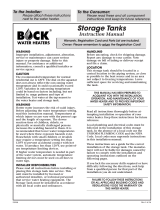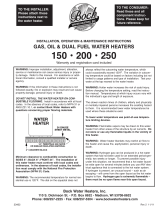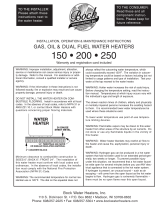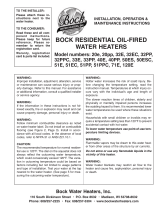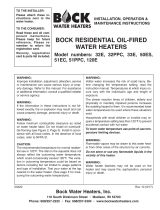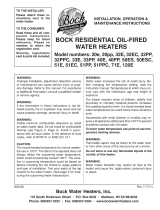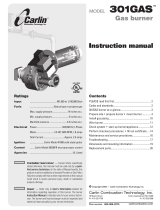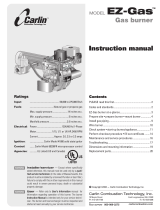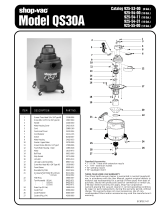Page is loading ...

which could occasionally exceed 120
o
F
. The variation in
outcoming temperature could be based on factors in
-
cluding but not limited to usage patterns and type of
installation. Test your water at the tap nearest to the wa-
ter heater.
WARNING: Hotter water increases the risk of scald in-
jury. Before changing the temperature setting, read the
instruction manual. Temperatures at which injury occurs
vary with the individual’s age and length of exposure.
The slower reaction times of children, elderly and phys-
ically or mentally impaired persons increases the
scalding hazard to them. It is recommended lower wa-
ter temperatures be used where these situations exist.
To lower water temperature use point-of-use tem-
perature limiting devices.
WARNING:
Flammable vapors may be drawn to this
water heater from other areas of the structure by air cur-
rents.
Do not store or use any flammable liquids in
the vicinity of this heater
.
WARNING: Water heater blankets may restrict air flow
to the heater and cause fire, asphyxiation, personal in-
jury or death.
W
ARNING:
Hydrogen gas can be produced in a hot
water system that has not been used for an extended
period–generally, two weeks or longer. To prevent pos-
sible injury under this situation, we recommend that a
hot water faucet be wide open for several minutes
before you use
ANY
electrical appliance that is connect
-
ed to the hot water system. If hydrogen is present, an
unusual sound – such as air escaping – will come from
the open faucet as the hot water begins to flow
.
Hydrogen gas is extremely flammable – there must
be no open flame near this open faucet.
TO THE INSTALLER:
Please attach these in-
structions next to the
water heater.
TO THE CONSUMER:
Read these and all
component instruc-
tions. Please keep for
future reference.
Waranty, registration card
& parts list included.
INSTALLATION, OPERATION
& MAINTENANCE INSTRUCTIONS
OIL-FIRED WATER HEATERS
72E • 73E • 190E • 241E • 361E • 541E
WARNING: Improper installation, adjustment, alteration,
service or maintenance can cause serious injury or
property damage. Refer to this manual. For assistance
or additional information, consult a qualified installer or
service agency.
WARNING: If the information in these instructions is not
followed exactly, fire or explosion may result and can
cause property damage, personal injury or death.
DO NOT INSTALL THE WATER HEATER ON COMBUSTI-
BLE FLOORING.
Install in accordance with all local
codes. In the absence of local codes, refer to NFPA 31
or ANSI Z21.10.1,
or contact Bock Water Heaters with
questions concerning proper flooring materials.
Minimum clearance to combustible construction is:
SIDES 6"; BACK 6"; FRONT 24". The installation of this
water heater must conform with local codes and ordi-
nances. In the absence of local codes, the installation
must comply with the National Fire Protection Associa-
tion (NFPA 31) Code.
WARNING: The recommended temperature for normal
residential use is 120
o
F. The dial on the aquastat does
not always reflect the outcoming water temperature,
Bock Water Heaters, Inc.
110 S. Dickinson St. • P.O. Box 8632 • Madison, WI 53708-8632
Phone: 608/257-2225 • Fax: 608/257-5304 • www.bockwaterheaters.com

– 2 –
PERFORMANCE SPECIFICATIONS
AND ROUGHING-IN DIMENSIONS
Leave ample room for servicing when the water heater is in-
stalled – do not block access to the burner, inspection door,
handholes or controls. Leave room to pipe the unit and connect
the fuel and electricity.
CAUTION:
The recommended
water temperature
setting for normal
residential use is
120
O
F.
73E, 190E, 241E, 361E
72E
SIZES AND CAP
ACITIES
(shipping weights are complete assembly, including burners and controls)
MODEL
STORAGE
CAPACITY
BTUH
INPUT
FIRING
RATE
STANDARD
VOLTAGE
MOTOR
SHIPPING WEIGHT
STANDARD ASME
541E
* Nipple not furnished ** Under drain valve
on 72E & 73E only
HOT
OUTLET *
COLD
INLET
DRAIN
ALT INLET/
RETURN **
BURNER SPECIFICATIONS
M
ODEL/OEM # NOZZLE PRESSURE
72E CARLIN EZ-2HP/9833222J72E 1.25X70
O
B 150 PSI
WAYNE MSR/371-019B 1.50X80
O
B 100 PSI
R
IELLO R35.5/C8512221 1.25X60
O
B
150 PSI
RIELLO 40F10/ 1.25X60
O
B 150 PSI
73E CARLIN EZ-2HP/9833222J73E 1.50X70
O
B 150 PSI
WAYNE MSR/371-022B 1.75X80
O
B 100 PSI
RIELLO 40F10/C8514109 1.50X60
O
B 150 PSI
190E WAYNE MSR/371-129B 1.35X70
O
B 100 PSI
CARLIN EZ-1/9682811J190E 1.35X70
O
B 100 PSI
BECKETT AF 1.35X70
O
B 100 PSI
241E CARLIN EZ-2HP/9833111J241E 1.65X70
O
B 150 PSI
WAYNE 371-024B 2.0X80
O
B 100 PSI
361E CARLIN 201CRD/98285000B361E 2.50X70
O
B 150 PSI
WAYNE EH/371-026 3.00X80
O
A 100 PSI
541E CARLIN 201CRD/98285000B541E 4.00X70
O
B 130 PSI
WAYNE EH/371-028 4.50X80
O
B 100 PSI
72E 67 GAL. 199,000 1.50 GPH 120V 60HZ 1/7 HP 550 LBS. ––
73E 67 GAL. 242,000 1.75 GPH 120V 60HZ 1/7 HP 550 LBS. ––
190E 113 GAL. 190,000 1.35 GPH 120V 60HZ 1/7 HP 690 LBS. ––
241E 109 GAL. 277,000 2.00 GPH 120V 60HZ 1/7 HP 925 LBS. 950 LBS.
361E 91 GAL. 415,000 3.00 GPH 120V 60HZ 1/4 HP 1105 LBS. 1125 LBS.
541E 83 GAL. 623,000 4.50 GPH 120V 60HZ 1/4 HP 1330 LBS. 1340 LBS.
MODEL A B C D E
72E & 73E
58
”
28”
20”
16”
8”
1
1
/
2
”*
1”
3/4”
1
1
/
2
”
190E 66
1
/
4
”31
1
/
2
”20
1
/
2
” 19” 6” 2”* 1” 3/4” 2”
241E
67
”
31
1
/
2
”
22”
19” 8” 2”* 1” 3/4” 2”
361E
67” 31
1
/
2
” 26” 23” 9” 2”* 1” 3/4” 2”
541E
66” 34” 30
1
/
2
” NA 10” 2”* 2”* 3/4” 2”

– 3 –
Care must be taken to insure an adequate air supply for the water heater.
A
. Install equipment only where the water heater will have satisfactory combustion, proper venting,
and the maintenance of temperature at safe limits all around the unit under normal operating con-
ditions. Free circulation of air around the water heater is essential. If the air supply is inadequate,
introduce outside air. Any temperature above 90
°
F around the heater indicates a need for addi-
tional air (see NFPA 31 for air requirements).
B. In addition to air needed for combustion, air may be required for draft control; cooling off; controlling
d
ew point; heating; drying; oxidation or dilution; safety exhaust; odor control; and compressors.
C. Make sure air around the water heater is adequate for personnel comfort and working conditions.
D. Check for proper draft. Place a draft gauge in the chimney above the draft diverter. Drafts should
be at least -0.02" W. C. and less than -0.05” W.C. while the water heater is in operation.
U
nconfined space:
N
o additional combustion and ventilation air is required if the volume of the
space is greater than 50 cubic feet per 1,000 BTUH of the combined total input of all equipment in-
stalled in that space. Rooms leading directly to the space through openings which cannot be closed
are considered part of the unconfined space.
Confined space: When the unit will be installed in a space with a volume of less than 50 cubic feet
per 1,000 BTUH, the space must be vented at the floor for combustion air and at the ceiling for ven-
tilation. This air can be supplied from either inside or outside of the building as conditions allow (refer
to NFPA 31 or local codes).
A. Inside air supply: Provide two permanent openings; one within 12" of the top of the enclosure and
one within 12" of the bottom, leading directly to room(s) of sufficient volume so that the combined
volume of all the space meets the criteria for unconfined space. Each opening requires a mini-
mum free area of one (1) square inch (two square inches total) per 1,000 BTUH of the combined
total input of all equipment installed in the enclosure, but not less than 100 square inches.
B. Outside air supply: Provide two permanent openings; one within 12" of the top of the enclosure
and one within 12" of the bottom. These openings must lead directly to crawl and attic spaces
leading directly to the outside of the building.
1.
Leading directly to outside or through vertical ducts: Each opening (top and bottom)
requires a minimum free area of one (1) square inch (two square inches total) per 4,000 BTUH
of the combined total input of all equipment installed in the enclosure.
2.
Leading to the outside through horizontal ducts: Each opening (top and bottom) requires
a minimum free area of one (1) square inch (two square inches total) per 2,000 BTUH of the
combined total input of all equipment installed in the enclosure.
Louvers and grilles: In calculating the “free” area in Equipment Located in Confined Spaces,
consider the blocking effects of louvers, grilles, or screens protecting openings. The screens cannot
be smaller than one (1) inch of mesh. If the “free” area of a louver or grille is known, it should be
used in calculating the size opening required to provide the “free” area specified. If the design and
“free” area is not known, assume wood louvers have 20% to 25% “free” area, and metal louvers and
grilles 60% to 75%. Fix louvers and grilles in the open position or interlock with the equipment so
they are opening automatically during equipment operation.
W
ATER PIPING:
Models 72E, 73E, 190E, 241E and 361E have polysulfone dip tubes. When using
sweat fittings, do not apply heat to the nipples. Pipe hot and cold lines with a union and valve on
each line.
If backflow preventers and pressure regulators are installed or if the heater is installed in a closed
system, allow for water expansion by installing either a thermal expansion valve or an expansion
tank in the system. Contact the local water supplier or plumbing inspector to correct the situation.
The Bock factory has installed the properly rated temperature and pressure (T&P) relief valve.
To prevent water damage when relief occurs, install a discharge line from the relief valve outlet to a
place for water disposal. Do not install reducing coupling or other restriction in the discharge line.
Arrange the line to allow complete drainage of both the relief valve and the discharge line. If the T&P
relief valve discharges periodically, service to the water system is required.
Do not place the shut-off valve between the relief valve and the water heater.
Check handholes for tightness.
1.
The operating thermostat and high limit are packed with the burner
. Mount the burner with bolts
provided. Burners are shipped with all settings at the approximate start point. Check inside the
combustion chamber to verify that the burner tube is not obstructed or protruding into the cham-
ber. Swing back the hinged transformer and rotate the blower wheel by hand a few turns to loosen
the pump seal.
COMBUSTION &
VENTILATION AIR
NOTE: All ducts
must have the same
cross sectional area
as the free area of
each opening to
which they connect.
The minimum side
dimension of a rec-
tangular duct must
be no smaller than
three (3) inches.
Caution: Operation
of exhaust fans, ven-
tilating systems,
power burners, in-
duced draft systems,
clothes dryers, or
fireplaces may cre-
ate conditions that
require special
attention to avoid
unsatisfactory oper-
ation of installed
equipment.
T&P RELIEF VALVE
ATTACH BURNER
& OIL LINES

– 4 –
2. Bock recommends a two-pipe (suction and return) system for these heaters. Use 1/2" O.D. soft cop-
per tubing (5/8” O.D. soft copper on Sun Tec H pumps) and install a bypass plug on two-pipe system.
(See instructions packed with pump.) Note: Do not install a bypass plug if using a gravity (one-pipe)
s
ystem. (See Figure 1.) For multiple heater installations, run a separate suction and return line for
each heater. (See Figure 2.) If the combined lift and horizontal run exceeds 100’, install a booster
p
ump as close to the supply tank as possible.
B
ooster pumps may be obtained from Sun Tec Hydraulics, Rockford, Ill.
3. Return lines must be the same diameter as suction lines and extend close to the
bottom of storage tank but stop slightly above suction lines. Use a minimum of fit-
tings and make bends in tubing with as large a radius as possible. Always use
flared fittings, not compression fittings. If pipe is used instead of tubing, do not con-
nect the burner to the pipe – use copper tubing and form a coil before attaching tub-
ing to burner.
4
. When installing an oil water heater with an existing oil tank and lines, check exist-
ing line sizes and compare to instructions shipped with the pump to see if they are
adequate. Do not use existing lines if they are smaller than 1/2" O.D. tube on
Models 361E and 541E. Proceed as follows:
A. If existing oil heater has a one-pipe system, tee into the system to furnish oil to the
heater.
B. If the existing oil heater has a two-pipe system, check whether the return line extends
to the bottom of the tank. It may be preferable to change the existing oil heater to a one-
pipe system and change the return line to the suction line for the heater.
C. If (B) is not applicable, tee into the existing suction line and the existing return line to
supply oil to the heater. Both suction and return lines must extend to the bottom of the
tank, but if the tubing is too small and a two-stage pump is on the existing oil appliance,
the water heater pump may be starved for oil.
D. If return lines do not extend to the bottom of the tank, use check valves on each suc-
tion line as close to each burner as possible to prevent air from being drawn through the
return line.
E. Before teeing into an existing oil line, check the vacuum gauge in the 1/4" inlet port or the vent
opening. A single-stage pump should not exceed 12" hg vacuum and a two-stage pump should not
exceed 17" hg vacuum on two-pipe systems.
If the heater performs poorly, recheck the vacuum reading – a high reading will indicate too much
resistance. This could be caused by a clogged filter, a restricted shutoff valve, kinked tubing, an ob-
struction in the oil line, excessive lift or too long a run.
F. If none of the above installations are suitable, Bock recommends an oil booster pump located as
close to the oil supply as possible. Use the existing supply and return lines for the booster pump.
Change the existing unit to a one-pipe system and tee off the one pipe to supply oil to the water heater.
Using “L” or “A” type venting, connect the heater to the chimney. Do not reduce the smoke pipe diam-
eter; use the same size smoke pipe as the heater flue pipe. Run a separate connector from the heater
to the chimney where possible. If the heater must be joined to another oil appliance breaching before
going into the chimney
, enlarge the existing breaching to accommodate the extra volume of gases from
the heater. The entrance into the breaching should be at a 45
O
angle.
W
iring must be done in accordance with the National Electrical Code and local ordinances. Burners are
supplied with an operating thermostat (Honeywell L4103A or Carlin EZ-Temp 90000B on 72E,
Honeywell L4006A or Carlin EZ-T
emp 90000C or Carlin EZ-T
emp 90300B on the 73E through 361E,
and Honeywell L8100C or Carlin EZ-T
emp 90300B on 190E and 541E). Models 73E through 541E
equipped with Honeywell controls are also supplied with a separate L40801B high limit (see wiring dia
-
grams). The operating thermostat should be set at 120
O
F for normal domestic hot water use; higher
temperatures increase the risk of scalding. Do not set higher than 180
O
F. The differential control wheel
on the L4006 control (73E-361E) should be set to 15
O
F
.
The high limit control (L4080B used on 73E-
541E) should be set 20
O
F or higher above the operating thermostat setting.
The maximum setting is 200
O
F
.
Fill the heater with water, opening a hot water faucet to allow trapped air to escape. Check handholes for
tightness. Check the fuel supply and all fuel lines for tightness. Rotate the blower wheel to loosen the
pump shaft seal. Bleed air from the oil line by opening the bleed valve on the fuel pump.
Attach a small
plastic tube to the bleed valve fitting on pump and run to a gallon container
. Turn on the electricity and set
the thermostat so the burner motor runs. The heater will not ignite when the bleed valve is open. Bleed
the line until the oil is completely clear (not milky or opaque), transparent and free of air bubbles and froth.
Shut the bleed valve and the burner will ignite. Remove the plastic tube. To keep the burner control from
PUTTING HEATER
INTO OPERATION
Install a water soft-
ener if the heater is
b
eing used in a hard
w
ater area (water
hardness of more
than seven grains).
G
RAVITY SYSTEM
FIGURE 1
CONNECT TO
CHIMNEY
ELECTRIC WIRING
FIGURE 2

– 5 –
locking out while bleeding, attach a jumper between the flame detector terminals after starting the burn-
er (remove the jumper when done). Double-check control settings as described previously.
1. Start the burner and adjust draft to the -.02 in H
2
O to -.05 in H
2
O.
2. Verify that the pump pressure matches the values in the chart.
3
. Check the smoke and adjust the air to give #1 smoke.
4
. Readjust to give a trace or zero smoke.
5. Check that the CO
2
/O
2
level is at 11% or higher. Note: Do not attempt to adjust the burner without
instruments.
6. Open the air adjustment to lower the CO
2
by .5% or 1% to allow for draft and fuel variations (refer
to the burner manufacturer’s recommendations).
The thermostat has been adjusted to 120°F at the factory. Wait until thermostat has shut off fuel to the
main burner; wait 30 seconds following shut off of fuel, then set thermostat to the highest temperature.
The main burner should re-light. Set thermostat to the lowest temperature; the main burner should go
out. The thermostat should be adjusted in accordance with the local codes or to the minimum setting
that will meet the hot water needs of the consumer. Bock recommends 120°F temperature settings for
residential applications for safety as well as energy efficiency.
1. Check the fuel supply
, electrical wiring and fuses. Make sure the temperature control is set for heat.
2. If the motor runs but there is no flame, remove the electrode assembly, clean and readjust. Check
the electrode porcelain for cracks and replace if necessary. Check the transformer to see if it is pro-
ducing a strong spark. (Use extreme caution – the transformer has a 10,000 volt output.) Check that
the coupling between the motor and pump shaft is not slipping. Check the set screw on the blower
wheel for tightness. Clean or replace the nozzle if necessary, always using the correct size and
spray angle provided by the manufacturer.
3. Bleed the pump to make sure the oil is clear and free of air bubbles. If the oil is milky or frothy, check
the line for air leaks at fittings. Check the oil filter gaskets and make sure the filter cartridge is clean.
4. If the burner motor does not run, check the motor thermal overload button (red) and reset. If the
burner motor does not run after pushing the red button on the back of the motor, turn the motor off
and check the motor shaft to see if it is tight. Check the pump shaft; if it is free and the motor will
not run, replace the flame detector located in the burner housing. Turn on the current and reset the
control (relay). If the motor still does not run, replace the control (relay). If motor hums and gets hot,
replace the motor.
5. If the burner ignites and runs a short time (10 to 15 seconds) and goes out on safety, replace the
flame detector. If the burner still runs only a short time, replace the control.
6. The smell of oil or combustion products may be caused by poor draft or lack of combustion air.
Remove and clean the electrode assembly and check the draft in the connector directly above the
heater. There should be at least .01 inches W.C.. draft (pull) or greater.
Lime and sediment: Such accumulations can be controlled to an extent by softening the water
.
The
tank should be inspected every six months by draining the tank, removing the hand hole cover, and
making a visual check of the tank interior. If lime (or sediment) has accumulated, it should be removed
by use of a commercial lime dissolving chemical or by scraping loose the deposit and flushing it away
through the hand hole or drain.
Excessive pressure is controlled by the T&P relief valve. Water expands when heated and the extra
volume of water must have a place to go. If water cannot expand into the cold water line because of a
check valve, pressure builds as the water heats. The pressure relief valve opens, and dumps the extra
volume of water. If the relief valve is faulty or none has been installed, the tank can fail due to this ex-
cessive pressure. Open the relief valve at least once a year to make sure the seat is not stuck.
Caution: Before opening the relief valve be certain that the discharge line directs the water away from
anything that could be damaged or would block the flow of water to the drain. Stand away from the
outlet to avoid contact with the water
.
Rods are installed in the head of the tank to help prevent corrosion of the tank. When inspecting the
tank interior for lime or sediment accumulations, also inspect the condition of the anode rods. When
either rod has eroded to about one third of its original diameter, it should be replaced.
Vent system should be checked at least once a year for damage and/or blockage.
If the water heater is to be shut off during cold weather, the tank and water lines should be drained to
prevent freezing and piping damage. Please see warning on hydrogen gas buildup on page 1.
IMPOR-
TANT!
The water heater warranty will be invalid if the tank fails due to excessive pressure, the accu-
mulation of lime or sediment, corrosion, or freezing. The Bock Water Heaters warranty (back page)
explicitly documents further causes of invalidation.
SET DRAFT AND
ADJUST BURNER
COMBUSTION
(see
b
urner instructions)
Regular maintenance
will keep the water
heater operating at
peak efficiency. The
tank can fail prema-
turely from the
accumulation of lime
and sediment in the
bottom, excessive
pressure and/or cor-
rosion.
SERVICE:
MAGNESIUM
ANODE RODS
FREEZING

– 6 –
Carlin burner w/
Carlin EZ-Temp
Models 72E, 73E,
190E, 241E,
361E, 541E
FIGURE 3
L4006A
L
4080B
L
8106
WAYNE
Models 73E - 541E
FIGURE 5
Wayne
Model 72E
FIGURE 4
Wayne burner
w/ Carlin EZ-Temp
(all models)
Beckett burner
with Carlin EZ-Temp
(Only 190E)
FIGURE 6

– 7 –
OIL-FIRED WATER HEATER
MODELS 72E, 73E, 190E, 241E, 361E & 541E
This is a tank assembly parts list. When ordering repair parts, always
give the part name, heater number (size) and serial number.
ITEM DESCRIPTION ITEM DESCRIPTION
1. Cold water inlet dip tube
(not on 541E)
2. Plastic cap
3. Anode rod
4. Top pan
5.
Hot out connection
6.
T
ank
7. Outer jacket
8.
Relief valve
9. Aquastat
10. Drain valve
1
1.
Burner mounting bracket
12. Burner mounting gasket
13. Bottom pan
14. Combustion chamber sleeve
15. Combustion chamber
16. Inspection plug
17. Inspection door
18.
Inspection door gasket
19. Burner
20. Relay
21.
Handhold cover plate
22. Handhold cover gasket
23. High limit
24.
Cad cell
FIGURE 7

LIMITED WARRANTY
WARRANTY COVERAGE:
This warranty covers “Bock” Water Heater models 72E, 73E, 190E, 241E, 361E and 541E. Bock Water
Heaters, a division of Bock Corporation – a Wisconsin corporation – at 110 S. Dickinson St., Madison, WI 53703, (“Company”), war-
rants to the owner that the tank of this water heater will not leak due to defective materials or workmanship for THREE (3) years from
the date of original installation. The company also warrants that no other part of this water heater will fail due to a defect in material or
workmanship for one (1) year. This warranty does not apply where the purchase is for resale.
COMPANY RESPONSIBILITY:
Bock Water Heater’s responsibility is to repair or replace, at our option with the prevailing comparable
model, any part of the equipment sold by the Company which proves to be defective in material or workmanship, including the tank,
during the warranty period when installed in accordance with applicable codes and ordinances and operated and maintained in accor-
dance with our instructions, subject to the conditions and exceptions indicated below
. Our liability, in the vent of leakage or other mal-
function, is strictly limited to repair or replacement of the defective heater or part as provided herein. We are not responsible hereun-
der for incidental property damage or personal injury, consequential costs or damage.
OWNER RESPONSIBILITY:
At the company’s request, the owner is to return to the factory at Madison, WI any part, including the tank,
defective in material or workmanship and pay all transportation charges for such return parts and for replacement parts sent from the
factory to the owner. The owner will pay all labor charges for the removal and installation of such parts, including the tank.
EXCEPTIONS:
This warranty will not apply to tanks or parts subject to misuse, abuse, neglect, alteration, accident, excessive temper-
ature, excessive pressure, lime, silt or sediment accumulation, corrosive atmosphere, the removal of anode rods, installation outside
of the USA, or on which the serial numbers have been altered.
The warranty also does not apply when the water heater is installed
without a new temperature and pressure relief valve and is not installed in accordance with local codes and ordinances.
T
OT
AL
WARRANTY COMMITMENT:
W
e will not assume nor authorize any person to assume for us any other liability in connection
with the sale or operation of Bock Water Heaters. Any implied warranties, including merchantability or fitness for a particular applica-
tion imposed on the sale of this heater under laws of the state of sale are limited to one (1) year. Some states do not allow limitations
on how long an implied warranty lasts or for the exclusion of incidental or consequential damages, so the above limitations or exclu-
sions may not apply to the purchaser
.
This warranty gives specific legal rights – other rights may vary from state to state.
WARRANTY REGISTRATION:
The card should be returned within thirty (30) days of the date of installation; otherwise, the date of
manufacture will be recorded as the date of installation for the purpose of this warranty.
TO MAKE A CLAIM:
Contact your nearest Bock distributor or:
Bock Water Heaters, Inc. • 110 S. Dickinson St. • Madison, WI 53703
Phone: 608/257-2225 • Fax: 608/257-5304 • www.bockwaterheaters.com
Form 23400
Rev 4
2/2007
BURNER PARTS LIST
15
13
ITEM DESCRIPTION
1. . . . . . . . . . . . . . . . . . . . . . . . . . . . . .Burner Housing
2. . . . . . . . . . . . . . . . . . . . . . . . . . . .Junction Box ASM
3. . . . . . . . . . . . . . . . . . . . . . . . . . . . . . . . . . . . . .Motor
4. . . . . . . . . . . . . . . . . . . . . . . . . . . . . . . .Blower Wheel
5. . . . . . . . . . . . . . . . . . . . . . . . . . . .Motor Cord Cover
6. . . . . . . . . . . . . . . . . . . . . . . . . . . .Transformer/Igniter
7. . . . . . . . . . . . . . . . . . . . . . . . . . . . . . .Housing Cover
8. . . . . . . . . . . . . . . . . . . . . . . . . . . . . . . . . . . .Coupling
9A. . . . . . . . . . . . . . . . . . . . . . . . . . . . . . . . . . .Fuel Unit
10. . . . . . . . . . . . . . . . . . . . . . . . . . . .Oil Line Assembly
11. . . . . . . . . . . . . . . . . . . . . . . . .Air Adjst. Band, Inner
12. . . . . . . . . . . . . . . . . . . . . . . . .Air Adjst. Band, Outer
13. . . . . . . . . . . . . . . . . . . . . . . . . . . . . . . . . . . .Air Tube
13. . . . . . . . . . . . . . . . . . . . . . . . . . . . . . .Gun Assembly
14. . . . . . . . . . . . . . . . . . . . . . . . . . . . . . . . . . . . .Gasket
15. . . . . . . . . . . . . . . . . . . . . . . . . . . . .Mounting Flange
17. . . . . . . . . . . . . . . . . . . . . . . . . . . . . . .Oil Line Elbow
18. . . . . . . . . . . . . . . . . . . . . . . . . . . . . . . . . . .Air Cone
19. . . . . . . . . . . . . . . . . . . . . . . . . . . . . .Nozzle Adapter
20. . . . . . . . . . . . . . . . . . . . . . . . . . . .Electrode Support
21. . . . . . . . . . . . . . . . . . . . . . . .Electrode Asmbly (RH)
22. . . . . . . . . . . . . . . . . . . . . . . .Electrode Asmbly (LH)
14
18
13
17
CAD CELL
9A
12
1
1
1
10
4
7
6
3
5
2
RELAY (where listed)
Please have burner make, model and serial number available when
ordering parts.
/

